MVTec
HALCON Progress 24.05
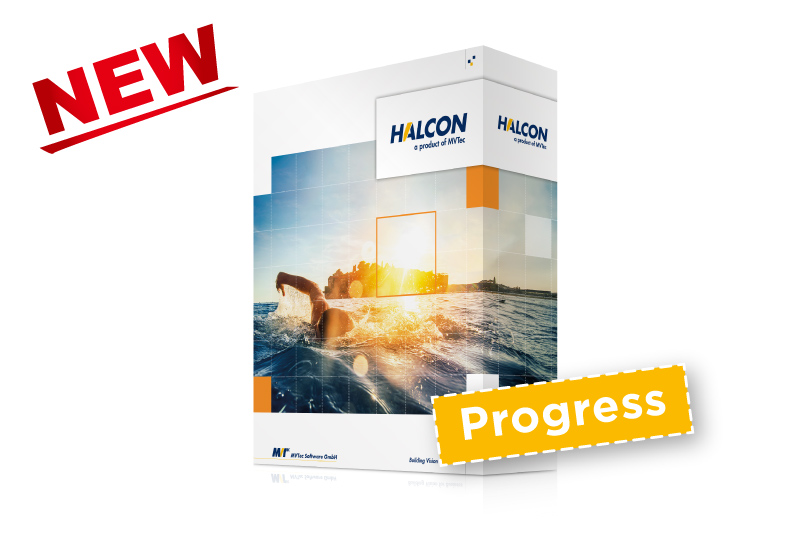
MVTec HALCON is the comprehensive standard software for machine vision with an integrated development environment (HDevelop) that is used worldwide. It enables cost savings and improved time to market. HALCON’s flexible architecture facilitates rapid development of any kind of machine vision application.
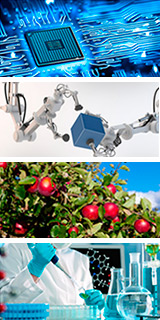
Highlights
- HALCON is your solution for the full range of applications in the field of machine vision
- Enabler of the Industrial Internet of Things (aka Industry 4.0)
- Large imaging library of more than 2,100 operators
- Integrated development environment (IDE) for machine vision: HDevelop
- Huge range of features including deep learning
- Easy programming in C, C++, C#, Python, and Visual Basic .NET
- Available for a multitude of platforms
- Support of multi-core and multiprocessor computers
- High performance through utilization of state-of-the-art instruction sets and GPU Acceleration
- Support of hundreds of industrial cameras, frame grabbers, and all common vision standards
Features
- Revolutionary software for 3D machine vision
- Matching to find even rotated or partly occluded objects
- Blob analysis with more than 50 shape and gray value features
- High-accuracy measuring
- Huge range of latest deep learning technologies
- Optical character recognition and verification (OCR/OCV)
- Arbitrarily shaped regions of interest (ROIs) for significant flexibility and speed
- Detection of lines, circles, and ellipses with an accuracy of up to 1/50 pixel
- Extremely fast morphology
- Color image processing and hyperspectral imaging
- Processing of extremely large images (more than 32k x 32k)
- Image sequence processing (e.g., for surveillance tasks)
- Accurate 3D camera calibration
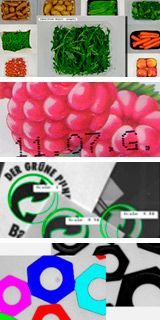
>HALCON 24.05
Extended parameter estimation for Shape Matching
HALCON 24.05 introduces the first iteration of the extended parameter estimation for Shape Matching. With its subpixel accuracy, Shape Matching finds objects robustly and accurately in real-time, even in the most challenging situations. Thanks to the extended parameter estimation, manual parameter adjustments will soon be a thing of the past. Using multiple annotated images, users can now easily optimize for maximum online speed while keeping robustness through automated parameter tuning. Users thus benefit from a faster implementation of shape matching applications, even without specialized expertise. Shape Matching has never been easier!
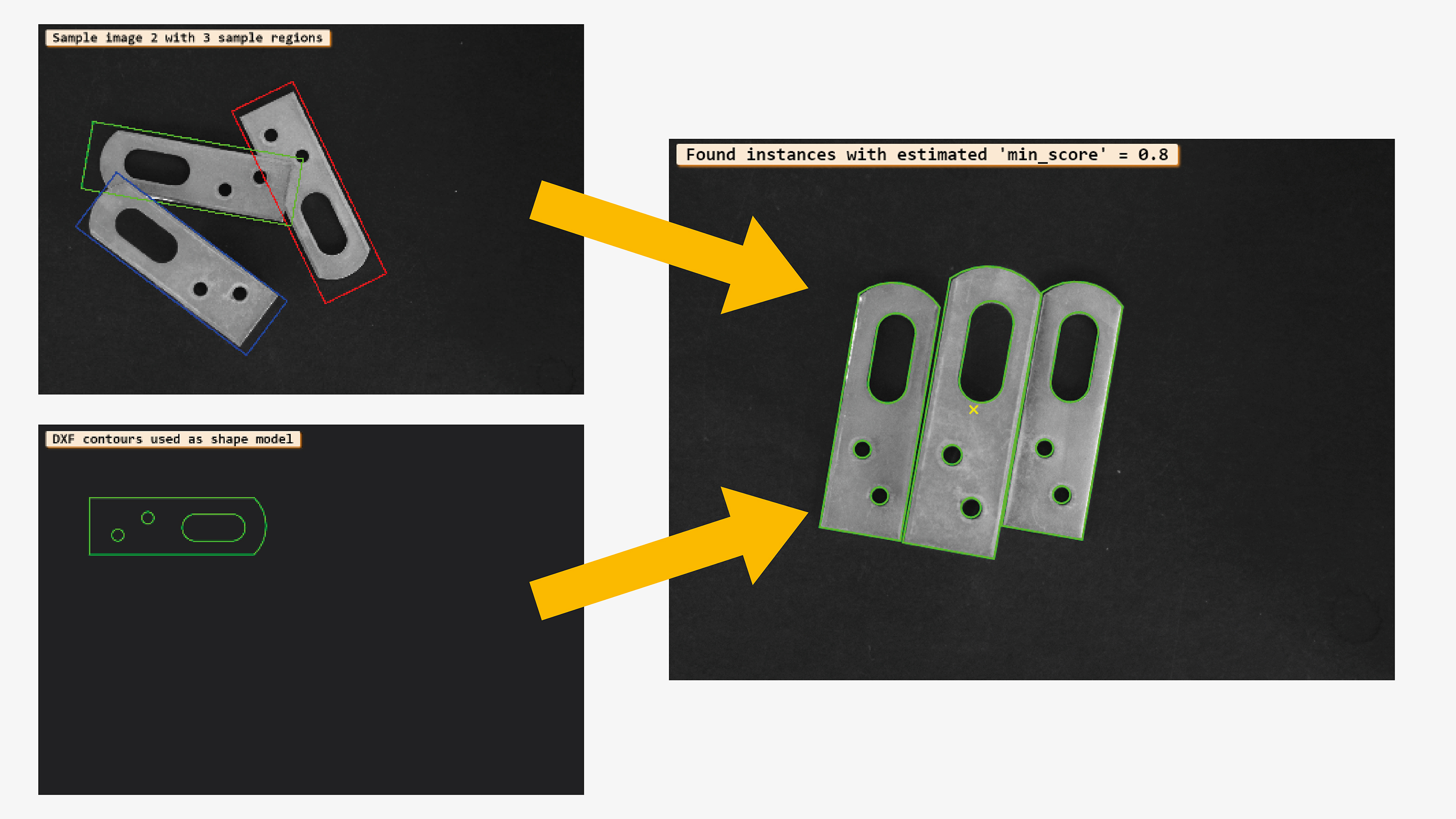
Bar code reader improvements for stacked bar codes
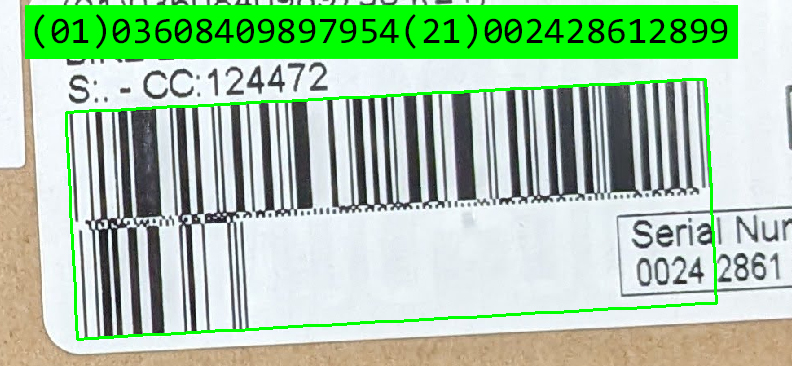
Importing 3D object models from the STEP format
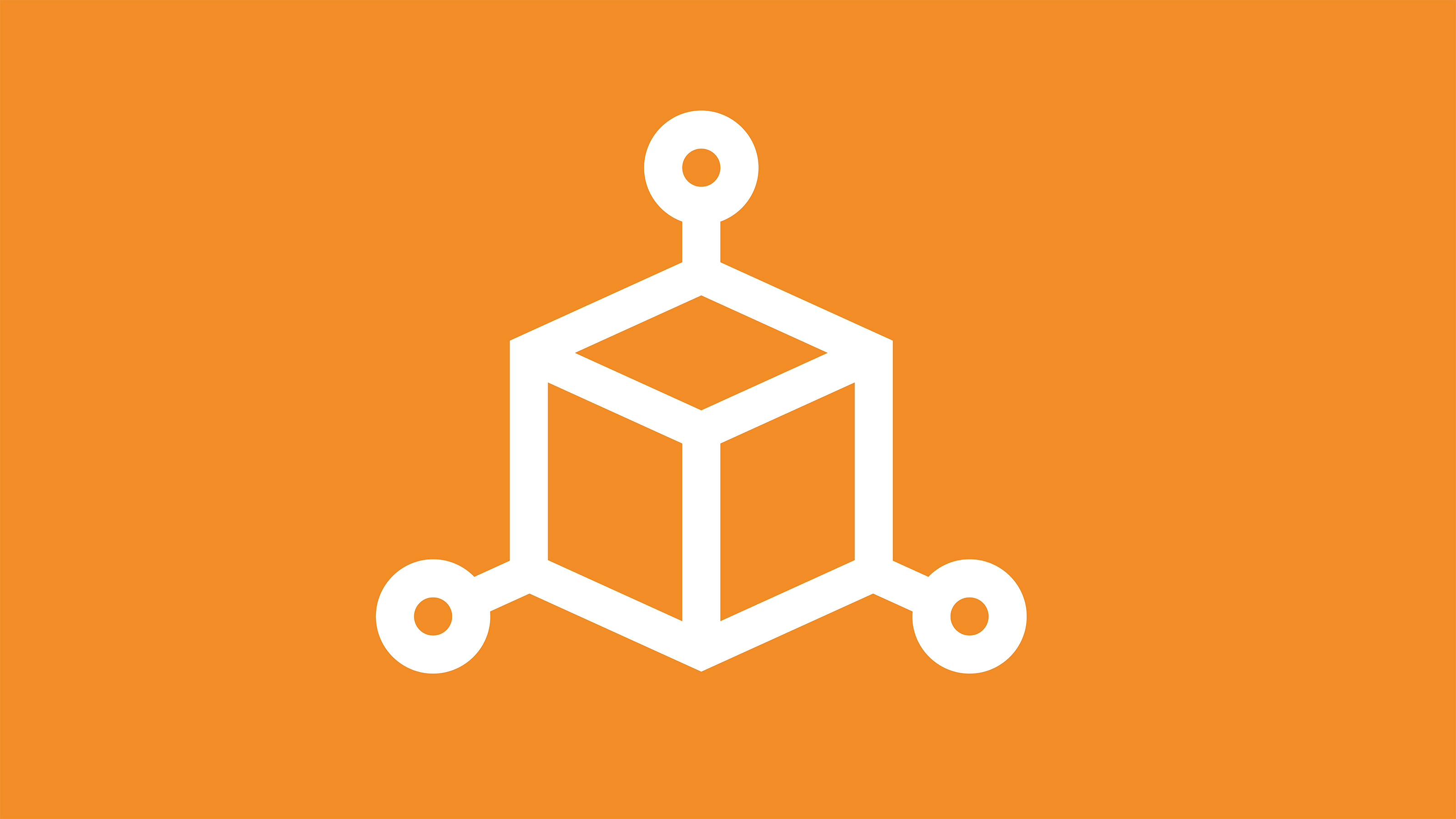
New version of the OpenVINO™ Toolkit AI² plugin

Speedups and further improvements

>HALCON 23.11
MVTec license server cloud ready
With HALCON 23.11, customers have an additional "cloud-ready" variant of the license server at their disposal. This now makes it possible to license HALCON in the environments of commercial cloud providers as well as in enterprise-owned cloud setups without the need for a hardware dongle, solely through a network connection. This means that HALCON can now be easily licensed across all cloud solutions. By using HALCON in the cloud, customers can easily benefit from the new possibilities offered by machine vision in the cloud.

Structured light 3D reconstruction
In HALCON 23.11, the structured light model has been enhanced: besides deflectometry, it now also provides precise 3D reconstruction for diffuse surfaces in short cycle times. This enhancement gives users the flexibility to develop their own application-specific 3D reconstruction systems using a pattern projector and a 2D camera. The feature is particularly suitable for applications where precise spatial representations are required. As a result, the technology is suitable for the optimization of manufacturing processes, quality control, and the precise measurement of various surfaces.

Multi-Label Classification
In the new HALCON version, customers now have access to multi-label classification, a new deep learning method that allows the recognition of multiple different classes on a single image. Such classes can encompass various properties of the objects within the image, for example defect types, color, or structure. In practice, this method can, for instance, reveal the presence of different types of defects in an image, allowing a more detailed classification. Compared to other methods, this deep learning method is faster in processing and the effort for labeling is also lower.
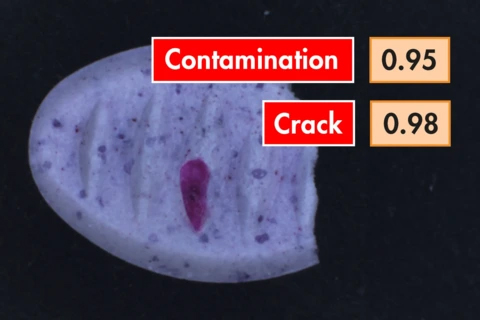
Further Improvements
In HALCON 23.11, a number of improvements for existing methods and technologies were implemented. For Global Context Anomaly Detection, a method for detecting complex anomalies, the underlying neural network has been further optimized. This improves the accuracy of anomaly detection without increasing hardware requirements or execution time. In addition, HALCON now utilizes the latest NVIDIA® CUDA® toolkit. This provides users with the opportunity to choose from an even greater range of AI accelerators. For example, the new NVIDIA Jetson OrinTM modules are now supported as well. Finally, several performance optimizations of HALCON's core technologies have been implemented in HALCON 23.11. For example, template matching operators (NCC Matching) now run up to 80% faster on Arm-based systems.
>HALCON 23.05
DEEP COUNTING
With Deep Counting, a feature is available to customers as of HALCON 23.05 that can be used to count a large number of objects quickly and robustly as well as to detect their position. The deep-learning-based technology offers significant advantages over existing machine vision methods: The feature can be deployed very quickly, since only very few objects need to be labeled and trained – both steps can be easily done within HALCON. The technology provides reliable results even for objects of highly reflective and amorphous material. With Deep Counting large numbers of objects such as glass bottles, tree trunks, or food can be counted.
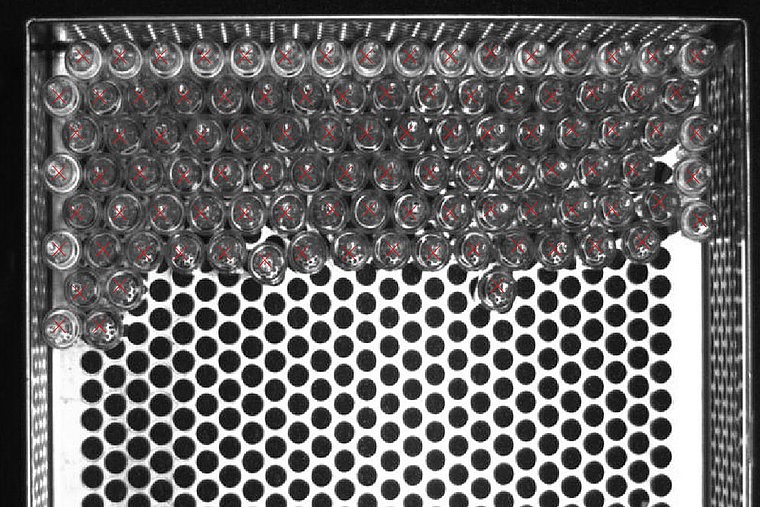
TRAINING FOR DEEP OCR – DETECTION
Deep OCR reads texts in a very robust way, even regardless of their orientation and font. For this purpose, the technology first detects the relevant text within the image and then reads it. With HALCON 23.05, it’s now also possible to fine-tune the text detection by retraining the pretrained network with application-specific images. This provides even more robust results and opens new application possibilities. For example: the detection of text with arbitrary printing type or unseen character types as well as an improved readability in noisy, low contrast environments.
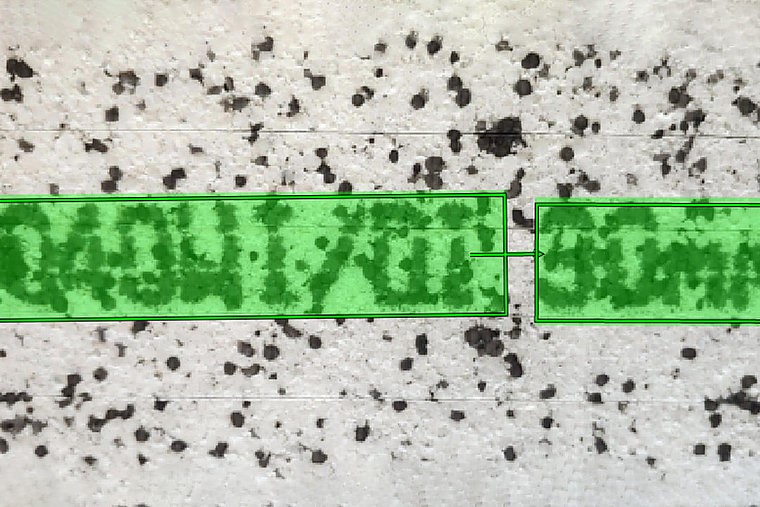
3D GRIPPING POINT DETECTION
HALCON 22.11 combines 3D vision and deep learning for the first time. The 3D Gripping Point Detection can be used to robustly detect surfaces on any object that is suitable for gripping with suction. In contrast to classic bin-picking applications, the 3D Gripping Point Detection is a CAD-less approach, hence no prior knowledge of the respective objects is required. This increased flexibility opens up completely new application fields, such as those in the logistics industry or warehouses.
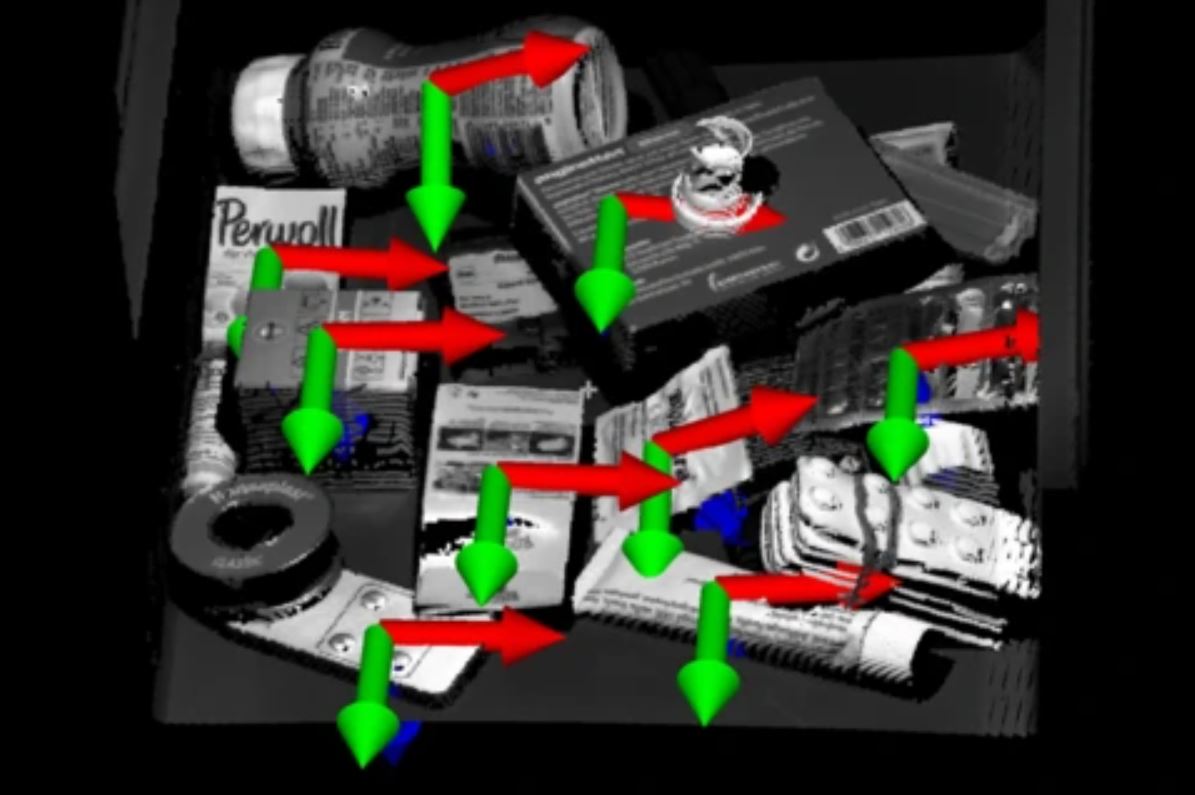
NEW DATA TYPE “MEMORY BLOCK”
As of HALCON 22.11, users can store and transfer binary data (e.g., images) in HALCON as well as further process it with other applications. This increases the software’s compatibility with machine communication protocols, such as OPC UA or image acquisition interfaces.

PROTECTION OF TRAINED DEEP LEARNING MODELS
For machine vision applications, the protection of intellectual property is getting more and more important. This is particularly relevant in the field of deep learning. The special aspect regarding this technology is that compared to traditional methods, the quality depends not only on the algorithm itself but also significantly on the quality of the training data. A large part of the effort of deep learning applications is in collecting the data and training the models. Therefore, HALCON 22.11 includes a new encryption mechanism for HALCON data types. One major use case is the encryption of deep learning models. This allows customers to protect their investment and know-how. Thanks to this, it is ensured that only authorized users can use and view their deep learning model.

BETTER TRACEABILITY OF DEEP LEARNING DECISIONS
A heatmap gives an indication of which areas of an image were decisive for the result of the deep learning model's classification. This can shed more light into the black box of deep learning, thereby increasing the traceability of corresponding processes. Guided Grad-CAM is a new method that now provides even more precise clues as to which regions of the image are relevant for the decision made by the deep learning network. For example, misclassifications can be investigated more precisely in a post-processing step.
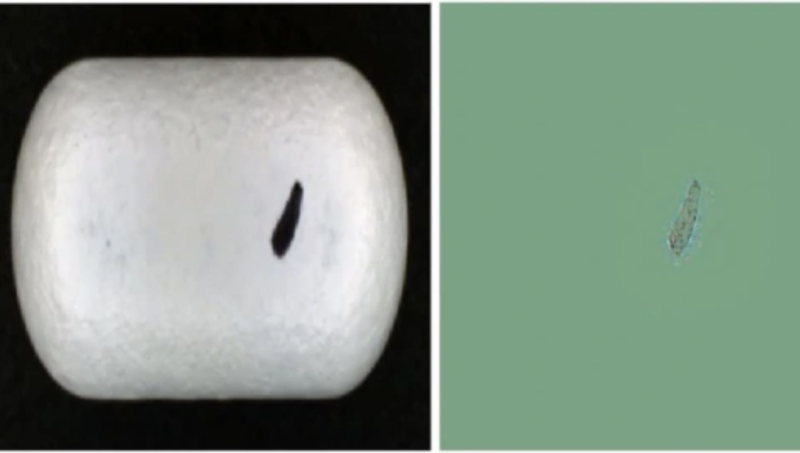
NETWORK LICENSES
With HALCON 22.11, MVTec expands the licensing possibilities by adding the option to license HALCON via a network. A license server allows the use of floating licenses. Here, developers share a predefined number of licenses using a network connection. Customers benefit from cost savings due to multi-usage and greater flexibility in user allocation, developers enjoy greater independence and flexibility regarding their work location. Especially for distributed or remotely working development teams, this is the perfect way to effectively make use of HALCON’s powerful machine vision algorithms. Besides this, the new mechanism enables users to work in virtualized environments without permanent physical host ID.
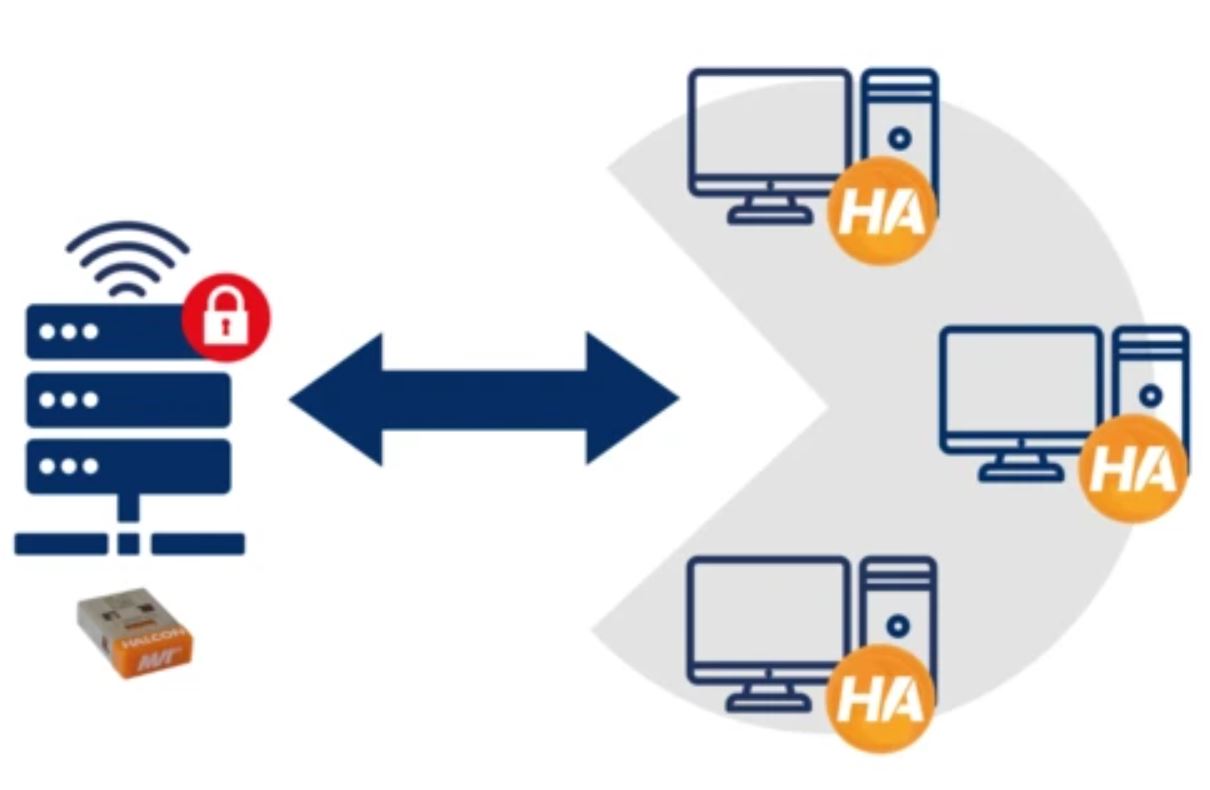
DEEP OCR TRAINING
HALCON's Deep OCR enables users to efficiently solve text reading applications in a multitude of use cases. With HALCON 22.05, this technology is extended by training functionality, enabling application-specific training on the user's own application dataset. This allows you to solve even most complex applications like reading text with bad contrast (e.g., on tires). Another advantage is that very rarely used special characters or printing styles can also be trained. Training for Deep OCR significantly improves the performance and usability and makes applications run even more robust.

Reading text with bad contrast and lighting conditions on tires without ...
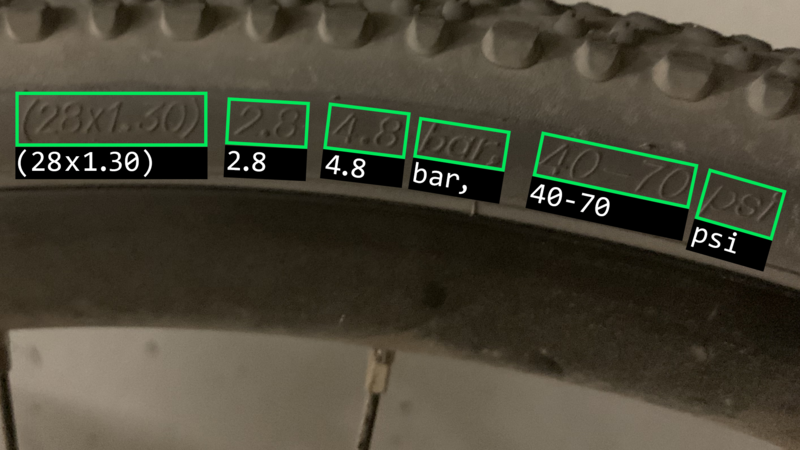
and with the new Deep OCR training.

GLOBAL CONTEXT ANOMALY DETECTION
HALCON 22.05 opens up completely new application possibilities with the detection of logical anomalies in images. This is the further development of the deep learning technology anomaly detection. Until now, it was possible to detect local, structural anomalies. The new “Global Context Anomaly Detection” is a one-of-a-kind technology, which is able to "understand" the logical content of the entire image. Just like HALCON`s existing anomaly detection the new “Global Context Anomaly Detection” only requires "good images" for training, eliminating the need of data labeling.This technology makes it possible to detect entirely new variants of anomalies like missing, deformed, or incorrectly arranged components. It opens up completely new possibilities: For example, the inspection of printed circuit boards in the semiconductor production or the inspection of imprints.
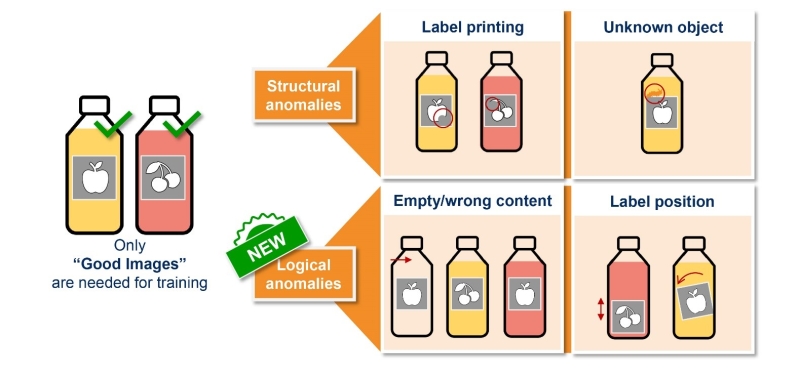
IMPROVED PRINT QUALITY INSPECTION FOR ECC 200 CODES
Print Quality Inspection (PQI) refers to the evaluation and grading of certain aspects of printed bar and data codes according to international standards. For example, it indicates how reliable a code can be read by various code readers or how stable the print quality is in a manufacturing process. HALCON supports various standards for grading the print quality of 1D and 2D codes. With HALCON 22.05, the PQI of data codes has been further improved. It is now up to 150% faster. In addition, the module grid determination for print quality inspection of ECC 200 has been improved. Last but not least, the usability of the PQI of data codes has been improved by introducing a new procedure that provides the grades.
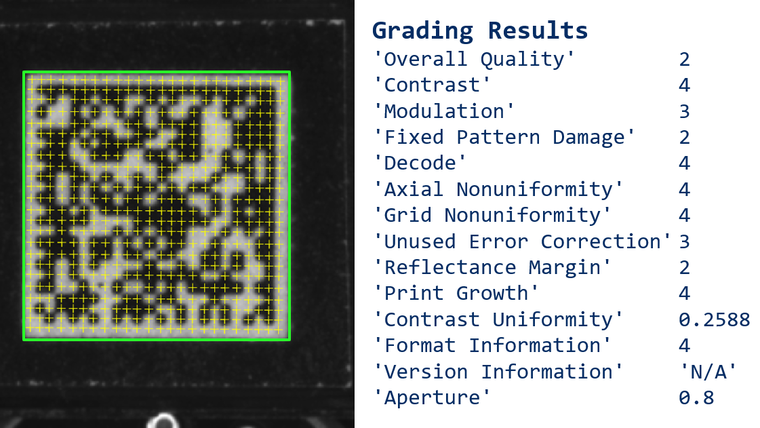
QUALITY-OF-LIFE IMPROVEMENTS AND SPEED-UPS
With HALCON 22.05, various improvements are released. One example is a new operator that performs adaptive histogram equalization to improve contrast locally in an image. This helps to extract significantly more information from images with low contrast, especially in case of inhomogeneous gray value gradient. Besides, the HALCON library has been extended with a new operator which allows image smoothing with arbitrarily shaped regions. Furthermore, another new operator allows you to transform 3D points using a rigid 3D transformation that is specified as a dual quaternion. And finally, HDevelop’s Matching Assistant now generates the code based on Generic Shape Matching.
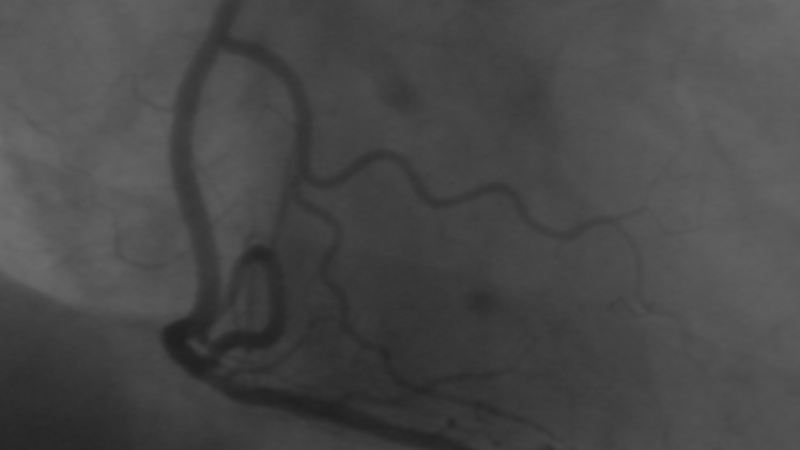
Original image
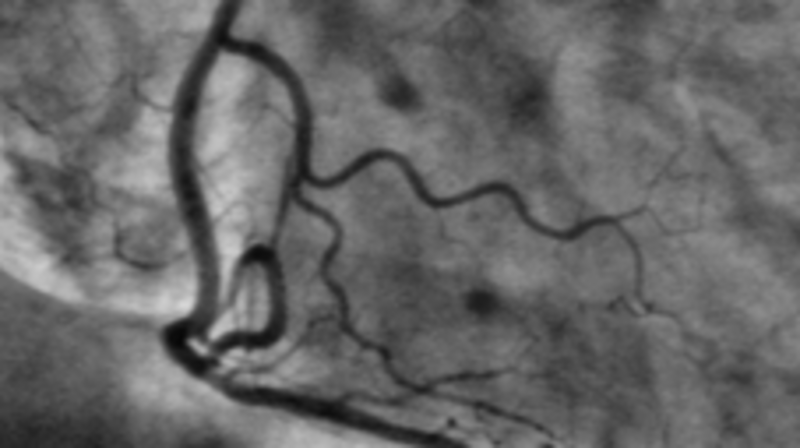
Contrast improved using adaptive histogram equalization
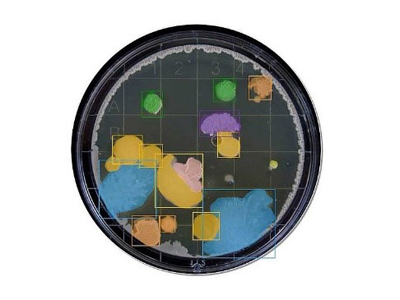
HALCON 21.11: Highly accurate identification and measurement of bacteria in petri dish
DEEP LEARNING INSTANCE SEGMENTATION
With HALCON 21.11 MVTec extends the functional scope of its deep learning features with a new technology called “instance segmentation”. This combines the advantages of semantic segmentation and object detection. With the help of instance segmentation, objects can be assigned to different classes with pixel accuracy. This technology is particularly useful in applications where objects are very close to each other, touch or overlap. Typical use cases also include grabbing randomly arranged objects from boxes (bin picking) as well as identifying and measuring naturally grown structures.
IMPROVED BAR CODE READER FOR CODE 128
With HALCON 21.11, HALCON’s bar code reader is improved in terms of robustness in case of blurred Code 128/GS1-128 codes. Now, codes with a larger amount of blur can be read. Blur on such codes can occur due to motion or due to limitations in depth of focus. The Code 128/GS1-128 is a widely used bar code type that is frequently used in logistics due to its compact size and high data density.

HALCON 21.11 reading a blurred Code 128 bar code
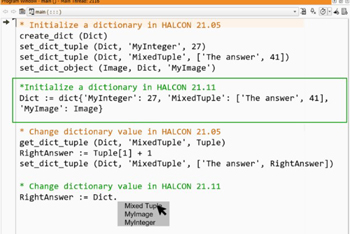
HALCON 21.11 Improved Dictionary Handling
IMPROVED DICTIONARY HANDLING
Dictionaries make it easy and convenient to manage complex data in HALCON. For example, different data types such as images, ROIs and parameter settings can be bundled in a single dictionary. This allows programs to be structured in a logical way, for example when passing many parameters to a procedure. HALCON 21.11 includes several improvements that make the handling of dictionaries even easier and faster. For example, dictionaries can now be initialized with a single operator call, and the syntax for adding and retrieving elements has been simplified. In addition, the auto-completion now also suggests the keys contained in the dictionary, which further speeds up and simplifies working with dictionaries.
FUTURE-PROOF INTERFACE FOR SHAPE MATCHING
With Generic Shape Matching, HALCON offers user-friendly access to MVTec's industry-proven shape matching technologies. Thanks to the significant reduction in the number of required operators, users can implement solutions more easily and quickly. With HALCON 21.11, existing functionalities are enhanced based on customer feedback to further increase usability. For example, the clutter feature has been integrated, handle inspection has been optimized, and additional parameters have been integrated and included in the automatic parameter estimation.
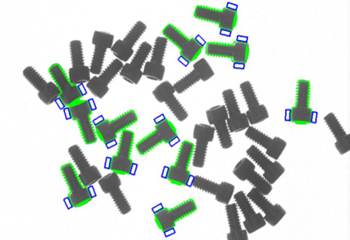
HALCON 21.11 Future-Proof Interface for Shape Matching
Deep learning edge extraction is a new and unique method to robustly extract edges (e.g., object boundaries) that comes with two major use cases.
Especially for scenarios where a variety of edges is visible in an image, it can be trained with only few images to reliably extract the desired edges. Hence, the programming effort to extract specific kinds of edges is highly reduced with this version of MVTec HALCON. Besides, the pretrained network is innately able to robustly detect edges in low contrast and high noise situations. This makes it possible to extract edges that usual edge detection filters cannot detect.
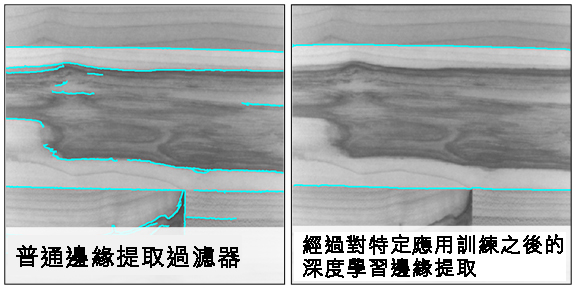
MVTec's deep learning edge extraction can distinguish between
parquet joints and the wood grain.

AGRICULTURE & FOOD
Identification of natural products,automated fruit picking and sorting, or fill level measurement: HALCON is a technology for producers and packagers alike to achieve efficient and consistent production and keep up with the ever-changing demands of consumers.

AUTOMOTIVE & ROBOTICS
Determine the 3D pose of objects, extract 3D data for bin picking or robot path planning: HALCON's unique 3D vision techniques open new possibilities for numerous automotive and robotics applications.

LOGISTICS & PACKAGING
Quality control, completeness inspection, identification, or bar & data code reading: HALCON offers outstanding methods in all areas of logistics and packaging.

ELECTRONICS & SEMICONDUCTORS
Precise assembly, surface inspection or defect detection during the entire manufacturing process: With HALCON, system manufacturers are fully equipped to implement advanced processes at reduced costs.
HALCON Editions
|
Progress |
Steady |
|
|
